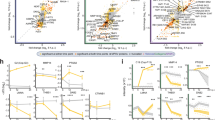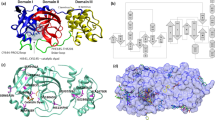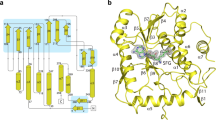Abstract
Poxviruses cause severe diseases, including smallpox and mpox, that pose major threats to human health. The poxvirus core protease (CorePro) is essential for viral maturation and is highly conserved in poxviruses, making it an attractive antiviral target1. However, the structure of CorePro remains unknown, hampering antiviral development. Here we determined the apo structure of monkeypox virus (MPXV) CorePro and the structure of CorePro in a complex with the inhibitor aloxistatin, a drug candidate for muscular dystrophy2. These structures show that CorePro forms a homodimer that features a unique ‘dancing couple’ fold. The catalytic intermediate state of CorePro was characterized by an aldehyde derivative from a natural substrate (I-G18). This derivative binds covalently to the catalytic Cys328, shifting the active site of the viral protease from a closed conformation in the apo form to a favourable open conformation upon substrate binding. On the basis of the CorePro–I-G18 complex, we designed a series of peptidomimetic inhibitors with a nitrile warhead, which could covalently anchor with the catalytic Cys328. These compounds inhibit CorePro with half-maximal inhibitory concentrations of 44.9–100.3 nM, and exhibit potent and broad anti-poxvirus activity. Our studies provide a basis for designing wide-spectrum inhibitors against poxvirus infections.
This is a preview of subscription content, access via your institution
Access options
Access Nature and 54 other Nature Portfolio journals
Get Nature+, our best-value online-access subscription
$32.99 / 30 days
cancel any time
Subscribe to this journal
Receive 51 print issues and online access
$199.00 per year
only $3.90 per issue
Buy this article
- Purchase on SpringerLink
- Instant access to full article PDF
Prices may be subject to local taxes which are calculated during checkout




Similar content being viewed by others
Data availability
All data generated or analysed during this study are included in the manuscript and the Supplementary Information files. Detailed information for compounds A1–A6, including 1H, 13C and 19F-NMR, high-resolution mass spectra (HRMS) and HPLC spectra results are shown in the Supplementary Information. The 3D cryo-EM density maps of CorePro in its apo form (EMDB-61300) and in complexes with aloxistatin (EMDB-62516), I-G18 (EMDB-62520), A1 (EMDB-61292), A3 (EMDB-61293) and A4 (EMDB-61294) have been deposited in the Electron Microscopy Data Bank (EMDB) database. The atomic models of CorePro in its apo form (9JAQ) and in complexes with aloxistatin (9KQV), I-G18 (9KR6), A1 (9JAL), A3 (9JAM) and A4 (9JAN) have been deposited in the Protein Data Bank (PDB). Additionally, the atomic models by X-ray crystallography of MPXV CorePro(I215K) (9KU9) and the catalytic domain of TATV CorePro (9KU2) have been deposited in the PDB. Source data are provided with this paper.
References
Byrd, C. M. & Hruby, D. E. Vaccinia virus proteolysis—a review. Rev. Med. Virol. 16, 187–202 (2006).
Satoyoshi, E. Therapeutic trials on progressive muscular dystrophy. Intern. Med. 31, 841–846 (1992).
Taube, J. C., Rest, E. C., Lloyd-Smith, J. O. & Bansal, S. The global landscape of smallpox vaccination history and implications for current and future orthopoxvirus susceptibility: a modelling study. Lancet Infect. Dis. 23, 454–462 (2023).
World Health Organization. Global Mpox Trends; https://worldhealthorg.shinyapps.io/mpx_global/ (2025).
Deputy, N. P. et al. Vaccine effectiveness of JYNNEOS against Mpox disease in the United States. N. Engl. J. Med. 388, 2434–2443 (2023).
Liu, H. et al. Global perspectives on smallpox vaccine against monkeypox: a comprehensive meta-analysis and systematic review of effectiveness, protection, safety and cross-immunogenicity. Emerg. Microbes Infect. 13, 2387442 (2024).
Lenharo, M. Hopes dashed for drug aimed at monkeypox virus spreading in Africa. Nature 632, 965 (2024).
Lum, F.-M. et al. Monkeypox: disease epidemiology, host immunity and clinical interventions. Nat. Rev. Immunol. 22, 597–613 (2022).
Lu, L., Su, S., Yang, H. & Jiang, S. Antivirals with common targets against highly pathogenic viruses. Cell 184, 1604–1620 (2021).
Owen, D. R. et al. An oral SARS-CoV-2 Mpro inhibitor clinical candidate for the treatment of COVID-19. Science 374, 1586–1593 (2021).
Schuele, L. et al. Real-time PCR assay to detect the novel clade Ib monkeypox virus, September 2023 to May 2024. Eurosurveillance 29, 2400486 (2024).
Kane, E. M. & Shuman, S. Vaccinia virus morphogenesis is blocked by a temperature-sensitive mutation in the I7 gene that encodes a virion component. J. Virol. 67, 2689–2698 (1993).
Ericsson, M. et al. Characterization of ts 16, a temperature-sensitive mutant of vaccinia virus. J. Virol. 69, 7072–7086 (1995).
Holm, L. Dali server: structural unification of protein families. Nucleic Acids Res. 50, W210–W215 (2022).
Pruneda, J. N. et al. The molecular basis for ubiquitin and ubiquitin-like specificities in bacterial effector proteases. Mol. Cell 63, 261–276 (2016).
Reverter, D. & Lima, C. D. A basis for SUMO protease specificity provided by analysis of human Senp2 and a Senp2–SUMO complex. Structure 12, 1519–1531 (2004).
Byrd, C. M., Bolken, T. C. & Hruby, D. E. Molecular dissection of the vaccinia virus I7L core protein proteinase. J. Virol. 77, 11279–11283 (2003).
Navia, M. A. et al. Three-dimensional structure of aspartyl protease from human immunodeficiency virus HIV-1. Nature 337, 615–620 (1989).
Wlodawer, A. et al. Conserved folding in retroviral proteases: crystal structure of synthetic HIV-1 protease. Science 245, 616–621 (1989).
Jin, Z. et al. Structure of Mpro from SARS-CoV-2 and discovery of its inhibitors. Nature 582, 289–293 (2020).
Qiu, X. et al. Unique fold and active site in cytomegalovirus protease. Nature 383, 275–279 (1996).
Shieh, H.-S. et al. Three-dimensional structure of human cytomegalovirus protease. Nature 383, 279–282 (1996).
Tong, L. et al. A new serine-protease fold revealed by the crystal structure of human cytomegalovirus protease. Nature 383, 272–275 (1996).
Yang, G. et al. An orally bioavailable antipoxvirus compound (ST-246) inhibits extracellular virus formation and protects mice from lethal orthopoxvirus challenge. J. Virol. 79, 13139–13149 (2005).
Tamai, M. et al. In vitro and in vivo inhibition of cysteine proteinases by EST, a new analog of E-64. J. Pharmacobiodyn. 9, 672–677 (1986).
Hook, G., Jacobsen, J. S., Grabstein, K., Kindy, M. & Hook, V. Cathepsin B is a new drug target for traumatic brain injury therapeutics: evidence for E64d as a promising lead drug candidate. Front. Neurol. 6, 178 (2015).
Hook, G., Hook, V. & Kindy, M. The cysteine protease inhibitor, E64d, reduces brain amyloid-beta and improves memory deficits in Alzheimer’s disease animal models by inhibiting cathepsin B, but not BACE1, beta-secretase activity. J. Alzheimers Dis. 26, 387–408 (2011).
Hook, G., Yu, J., Toneff, T., Kindy, M. & Hook, V. Brain pyroglutamate amyloid-beta is produced by cathepsin B and is reduced by the cysteine protease inhibitor E64d, representing a potential Alzheimer’s disease therapeutic. J. Alzheimers Dis. 41, 129–149 (2014).
Setoyama, K. et al. Toxicological studies of ethyl (+)-(2S,3S)-3-[(S)-3-methyl-1-(3-methylbutylcarbamoyl) butylcarbamoyl]-2-oxiranecarboxylate (EST) (report 1): acute toxicity studies of EST and metabolite and by-product of EST. Iyakuhin Kenkyu 17, 736–743 (1986).
Aleshin, A. E. et al. Activity, specificity, and probe design for the smallpox virus protease K7L. J. Biol. Chem. 287, 39470–39479 (2012).
Veber, D. F. et al. Molecular properties that influence the oral bioavailability of drug candidates. J. Med. Chem. 45, 2615–2623 (2002).
Nomura, A. M., Marnett, A. B., Shimba, N., Dötsch, V. & Craik, C. S. Induced structure of a helical switch as a mechanism to regulate enzymatic activity. Nat. Struct. Mol. Biol. 12, 1019–1020 (2005).
Marnett, A. B., Nomura, A. M., Shimba, N., de Montellano, P. R. O. & Craik, C. S. Communication between the active sites and dimer interface of a herpesvirus protease revealed by a transition-state inhibitor. Proc. Natl Acad. Sci. USA 101, 6870–6875 (2004).
Erbel, P. et al. Structural basis for the activation of flaviviral NS3 proteases from dengue and West Nile virus. Nat. Struct. Mol. Biol. 13, 372–373 (2006).
Kim, J. L. et al. Crystal structure of the hepatitis C virus NS3 protease domain complexed with a synthetic NS4A cofactor peptide. Cell 87, 343–355 (1996).
Love, R. A. et al. The crystal structure of hepatitis C virus NS3 proteinase reveals a trypsin-like fold and a structural zinc binding site. Cell 87, 331–342 (1996).
Ronau, J. A., Beckmann, J. F. & Hochstrasser, M. Substrate specificity of the ubiquitin and Ubl proteases. Cell Res. 26, 441–456 (2016).
Mastronarde, D. N. Automated electron microscope tomography using robust prediction of specimen movements. J. Struct. Biol. 152, 36–51 (2005).
Scheres, S. H. W. A Bayesian view on cryo-EM structure determination. J. Mol. Biol. 415, 406–418 (2012).
Punjani, A., Rubinstein, J. L., Fleet, D. J. & Brubaker, M. A. cryoSPARC: algorithms for rapid unsupervised cryo-EM structure determination. Nat. Methods 14, 290–296 (2017).
Punjani, A., Zhang, H. & Fleet, D. J. Non-uniform refinement: adaptive regularization improves single-particle cryo-EM reconstruction. Nat. Methods 17, 1214–1221 (2020).
Emsley, P., Lohkamp, B., Scott, W. G. & Cowtan, K. Features and development of Coot. Acta Crystallogr. D 66, 486–501 (2010).
Jumper, J. et al. Highly accurate protein structure prediction with AlphaFold. Nature 596, 583–589 (2021).
Liebschner, D. et al. Macromolecular structure determination using X-rays, neutrons and electrons: recent developments in Phenix. Acta Crystallogr. D 75, 861–877 (2019).
Pettersen, E. F. et al. UCSF Chimera—a visualization system for exploratory research and analysis. J. Comput. Chem. 25, 1605–1612 (2004).
Rosenthal, P. B. & Henderson, R. Optimal determination of particle orientation, absolute hand, and contrast loss in single-particle electron cryomicroscopy. J. Mol. Biol. 333, 721–745 (2003).
Kabsch, W. XDS. Acta Crystallogr. D 66, 125–132 (2010).
Pettersen, E. F. et al. UCSF ChimeraX: structure visualization for researchers, educators, and developers. Protein Sci. 30, 70–82 (2021).
Acknowledgements
The authors thank the Bio-Electron Microscopy Facility of ShanghaiTech University for technical support; the campus service team of ShanghaiTech University, scientific research platform of Shanghai Institute for Advanced Immunochemical Studies (SIAIS) and National Facility for Protein Science in Shanghai, as well as the managers and technicians who provided onsite or remote technical support; and the staff at the BL10U2 at Shanghai Synchrotron Radiation Facility (SSRF, China), where data were collected. This work was supported by grants from Shanghai Municipal Science and Technology Major Project (grant ZD2021CY001 to H.Y.); the Chinese Ministry of Education; Lingang Laboratory (grant LG202101-01-07 to H.Y.); the National Natural Science Foundation of China (grants 82130105, 82121005 and 92253305 to H.L. and grant 81902063 to W.W.); the Strategic Priority Research Program of Chinese Academy of Sciences (grant XDB0490000 to L.Z.); the Hubei Natural Science Foundation for Distinguished Young Scholars (grant 2022CFA099 to L.Z.); the Chongqing Science and Technology Bureau (grant CSTB2024NSCQ-MSX0391 to W.W.); the Chongqing Municipal Education Commission (grant KJQN202400433 to W.W.); the Shanghai Rising Star Program (grant 23QA1406400 to Y.G.); the Joint Funds of the National Natural Science Foundation of China (grant U22A20379 to W.D.); the Postdoctoral Fellowship Program and China Postdoctoral Science Foundation (grants BX20240374 and 2024M753225 to H.W.); and Shanghai Frontiers Science Center for Biomacromolecules and Precision Medicine of ShanghaiTech University.
Author information
Authors and Affiliations
Contributions
H.Y., H.L. and Z.R. conceived, initiated and coordinated the project. X.Z., T.Y., H.W., D.L., X.D., W.C., J.X., X.L., H.Z., S.M., H.J., M.J. and Z.S. purified the protein. Y.G., W.L., W.H. and M.Z. collected the cryo-EM data. Y.G. and W.L. processed cryo-EM data. Y.G. and W.W. built and refined the structure models. X.D. and D.L. identified and optimized the crystallization condition. H.W., W.W., Y.G. and X.J. collected X-ray diffraction data and determined the crystal structures. H.L., X.X., W.D., S.H. and B.W. designed and synthesized the peptidomimetic inhibitors. L.Z., J.C., Y.X., W.S. and Y.Z. performed the cell-based antiviral and cytotoxicity assays. X.Z., T.Y. and J.X. performed the enzymatic activity assay. H.Y., Z.R., H.L., L.Z., Y.G., X.X., T.Y., W.W., J.C., X.Z., Y.Y., Y.D., K.Y., X.J., X.Y., G.X. and B.Y. analysed and discussed the data. The manuscript was written by Y.G., W.W., X.X., J.C., H.C.N. and H.Y. All authors discussed the experiments and results, and read and approved the manuscript.
Corresponding authors
Ethics declarations
Competing interests
The authors declare no competing interests.
Peer review
Peer review information
Nature thanks Yi Shi and the other, anonymous, reviewer(s) for their contribution to the peer review of this work.
Additional information
Publisher’s note Springer Nature remains neutral with regard to jurisdictional claims in published maps and institutional affiliations.
Extended data figures and tables
Extended Data Fig. 1 Phylogenetic and conservation analysis of orthopoxvirus core proteases.
a, Amino acid sequence alignment of core proteases from the orthopoxviruses that infect humans. Conserved residues are shaded. Residues close to the active site are boxed and labeled. b, The positions of the residues that are not fully conserved are shown as red spheres on the structure of MPXV CorePro. The positions of the catalytic triad residues are shown as yellow spheres.
Extended Data Fig. 2 Representative protein purifications and enzymatic activities of MPXV and VARV CorePro.
a, MPXV CorePro eluted at ~13.2 mL on a Superdex 200 increase size-exclusion column, corresponding to a molecular weight between 67–158 kDa. The purity as judged by sodium dodecyl sulfate-polyacrylamide gel electrophoresis (SDS-PAGE) was >90%. b, MPXV CorePro cleaved a fluorescent substrate S-G32 derived from the second cleavage site of MPXV protein P25K. c, VARV CorePro is also a dimer and d, cleaves S-G32. AU is the abbreviation for arbitrary unit. The enzymatic activity data were derived from n = 4 biological replicates and are presented as mean values ± s.d.
Extended Data Fig. 3 Data process of MPXV CorePro in the apo-form and in complex with aloxistatin, I-G18, A1, A3 and A4.
a, Representative electron micrograph of the cryo-EM sample and CTF fit of the corresponding micrograph. b, Representative 2D classification averages calculated from selected particles. c, Workflow of the data processing. The overall map is colored according to the local resolution. d, Fourier shell correlation (FSC) curves of 3D reconstructions. e, Viewing direction of all particles used in the final 3D reconstruction. f, 3D FSC histogram of final map. g, Map to model FSC. The dotted line indicates FSC 0.143.
Extended Data Fig. 4 Purification and enzymatic activities of CorePro variants.
a, TATV CorePro and c, MPXV CorePro I215K eluted as a single peak on size-exclusion chromatography. The purity as judged by SDS-PAGE was >90%. TATV CorePro and MPXV CorePro I215K were in the right lane of the corresponding SDS-PAGEs; the left lanes were WT MPXV CorePro. Both b, TATV CorePro and d, MPXV CorePro I215K cleaved S-G32, a fluorescent substrate derived from the second cleavage site of MPXV protein P25K. e, MPXV CorePro D258A and g, D248A eluted on a Superdex 200 increase size-exclusion column. The purity as judged by SDS-PAGE was >90%. Neither f, MPXV CorePro D258A nor h, D248A was able to cleave S-G32. i, A MPXV CorePro variant, which consists of residues 1–405, eluted as a single peak on Superdex 75 Increase size-exclusion column and demonstrated >90% purity on SDS-PAGE, and j, did not cleave S-G32. AU is the abbreviation for arbitrary unit. The enzymatic activity data in b and d were derived from n = 4 biological replicates and are presented as mean values ± s.d.
Extended Data Fig. 5 The quality assessments of cryo-EM maps.
Cryo-EM densities for the indicated regions are shown: a, residues surrounding the active site of MPXV CorePro in the apo-form (Threshold: 0.4), the aloxistatin binding region (Threshold: 0.4), and the I-G18 binding region (Threshold: 0.6); b, The dimer interface of MPXV CorePro in the apo-form (Threshold: 0.7); c, Residues from Asn321 to Cys328 of MPXV CorePro in the apo-form and in complex with aloxistatin (Threshold: 0.4); d, The regions that can only be traced in CorePro-I-G18 complex (Threshold: 0.45). The structures of MPXV CorePro in the apo-form, in complex with aloxistatin and in complex with I-G18 are in gray, dark slate blue, and forest green, respectively. The cryo-EM densities are shown as grey with 40% transparency. The residues showing densities are labelled nearby.
Extended Data Fig. 7 Inhibition efficacy of aloxistatin and the peptidomimetic inhibitors.
a, Inhibiton activities of aloxistatin against MPXV CorePro and VARV CorePro, as well as compounds A1-A2 against MPXV CorePro. Each sample was tested in n = 4 biologically independent replicates and data are presented as mean values ± s.d. b, Representative curves showing VACV inhibition activity (black curves) and cell toxicity (blue curves) of aloxistatin and compounds A2-A6 in HeLa cell culture systems, and MPXV inhibition activity (black curves) and cell toxicity (blue curves) of aloxistatin in Vero-E6 cells. Data are presented as mean values ± s.d. from at least two technical repeats. EC50 values are expressed as mean values ± s.d. from at least n = 3 biologically independent replicates.
Extended Data Fig. 8 Cryo-EM structures of MPXV CorePro in complex with compound A1 and A4.
a, Cryo-EM map of MPXV CorePro in complex with compound A1 (Threshold 0.4). The CorePro domains, CD, NTD and CTD are in green, blue and red/orange, respectively. A1 is depicted in deep pink. Zoomed-in view of CorePro in complex with A1 is shown on the right. A1 is represented as sticks, accompanied by a local density map (Threshold 0.32). b, Depiction of the interactions between A1 and CorePro. c, Cryo-EM map of MPXV CorePro in complex with compound A4 (Threshold 0.4). A4 is depicted in pink. The local density map of A4 on the right is set to 0.35. d, Depiction of the interactions between A4 and CorePro.
Supplementary information
Supplementary Information
This file contains Supplementary Methods, Supplementary Figs. 1–8, Supplementary Scheme 1 and Supplementary Tables 1 and 2.
Rights and permissions
Springer Nature or its licensor (e.g. a society or other partner) holds exclusive rights to this article under a publishing agreement with the author(s) or other rightsholder(s); author self-archiving of the accepted manuscript version of this article is solely governed by the terms of such publishing agreement and applicable law.
About this article
Cite this article
Gao, Y., Xie, X., Zhang, X. et al. Substrate recognition and cleavage mechanism of the monkeypox virus core protease. Nature 643, 271–279 (2025). https://doi.org/10.1038/s41586-025-09014-x
Received:
Accepted:
Published:
Issue date:
DOI: https://doi.org/10.1038/s41586-025-09014-x



